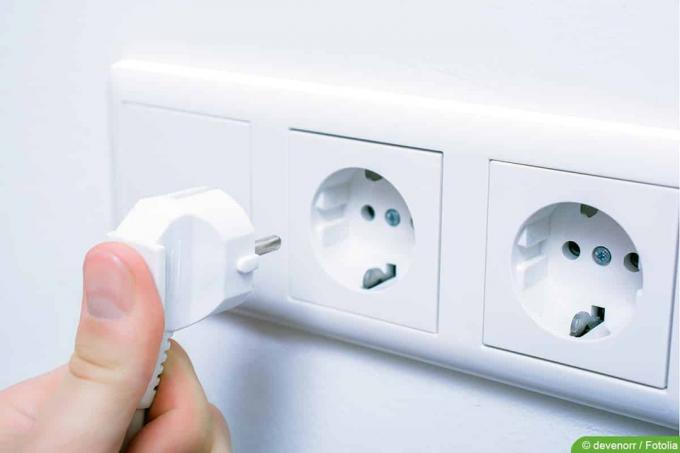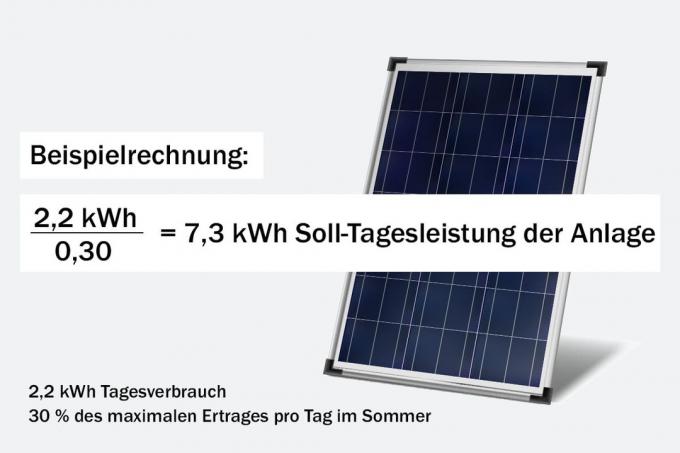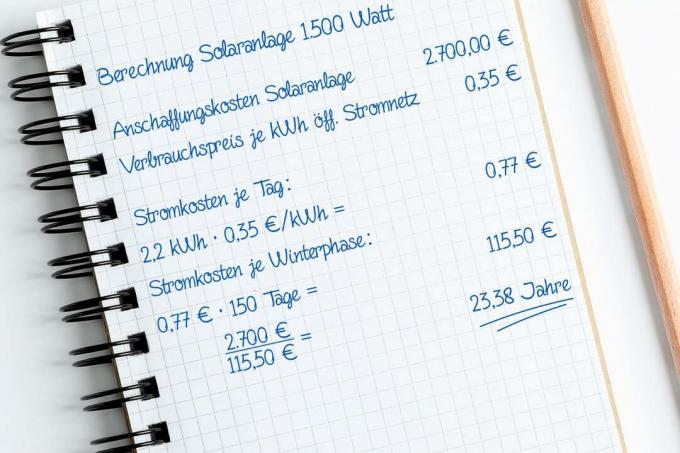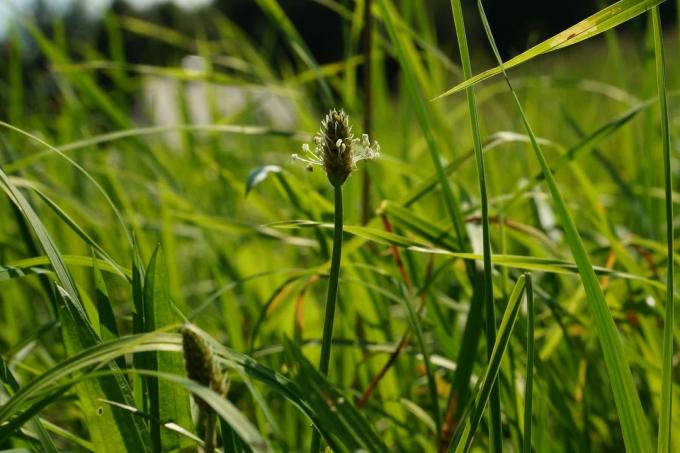

Table of contents
- Different season - different priorities
- home lighting
- garden lighting
- The solar system – makes sense in winter?
- The calculation example
- your consumption
- Collector area and current yield
- The economic perspective
- The consideration - solar system or not?
Winter means darkness means lighting – also around the house and garden. But how should one operate the system? When is it worth using a solar system? We explain how to assess needs and possibilities.
Different season - different priorities
Although your garden is of course still the same outside of the flowering and harvest seasons, the type of use is changing and therefore also the way you use it together with all your outdoor facilities illuminate. Where in summer, for example, sitting comfortably in the countryside is made even more pleasant with subtle light, the focus in winter is on a completely different type of lighting:
home lighting
Around your house, the main concern is to establish the safe usability of access points and paths, for example to the house, to the garage or to the bicycle shed. Because of the much shorter days, the number of uses in the dark increases enormously. Typical lighting variants are:
- Spotlights, often in conjunction with motion detectors
- Accompanying lights on paths
- Spots or spotlights under canopies or next to entrance doors
garden lighting
In the garden, on the other hand, the lighting of paths, for example to the compost heap, is also important. In addition, however, two other areas of application are much more important here:
decoration
Whether as a replacement for the missing green, or on special occasions such as Christmas or New Year's Eve - light creates joy and a pleasant atmosphere. In addition to decorative individual lights, chains of lights or other decorative installations, which today are mostly based on LEDs, are widespread.
plant lights
By the end of winter at the latest, however, it is also a matter of preparing for the upcoming growth and planting period. Shortly after the turn of the year, the first sprouts can be grown in greenhouses under special lighting that imitates and replaces the lack of sunlight.
The solar system – makes sense in winter?

When it comes to choosing the individual lighting elements and lamps, you have an almost unmanageably large number of options options are available, there are only two common ones when it comes to the power supply for your lighting Variants:
The mains power supply
Of course, you can connect all lamps to the power supply of your house in the usual way. This only requires lines to the distributor and possibly another sub-distributor with a separate protection for the garden. Sometimes outdoor and garden lighting can also be connected easily and with little effort via the garage or shed supply.
The photovoltaic system
If you generate your electricity yourself using a photovoltaic system, you can of course also use the electricity yourself, for example for your house lighting and your garden. Here, too, you need a line infrastructure for the supply, but using your own electricity will definitely have a positive effect on your account.
Or not?
To find out exactly that, you can use a simple rough calculation to determine whether your system produces enough electricity in winter. A second step then clarifies quite simply whether this procedure is economical.
A NOTICE:
In the following discussion, we assume a so-called stand-alone system that generates electricity and stores it in a battery. They are mainly used for gardens, holiday homes and other uses to a limited extent. Please do not confuse an island photovoltaic system with a photovoltaic system permanently installed on your house roof for feeding into the grid. Here, both yield and acquisition costs are disproportionately higher.
The calculation example
First of all, as a basis for any calculation, you need some basic parameters in the form of the output of your lamps. Ideally, refer to your specific consumers. For this example, on the other hand, we make use of common average values:
- LED light accompanying path or individual light, each approx. 6 watts
- Spotlight or spotlight, averaged as a mixed use of LED and other technology, approx. 25 watts
- Classic wall or ceiling lamp, approx. 25 watts
- Decorative lighting as a chain of lights, 200 LEDs, each chain approx. 60 watts
- Plant lights, each approx. 100 watts (area heater)
- Plant lights, each approx. 12 watts (single radiator)
your consumption
Unfortunately, it is not enough to simply add up your consumers and thus determine the performance. After all, it is not the pure power consumption of your lighting that is of interest, but the total consumption within a period of time, here within one day. Therefore, you now have to provide your individual lights with periods of time in order to get from the power in watts (W) to a power consumption per time in watt hours (Wh).

The lamps listed are again an example that you should of course replace with your actual lamp types and quantities:
- Path lighting 6 W, 8 pieces, operating time in the evening 6 hours = 288 Wh
- Spotlight 25 W, 2 pieces, operating time via motion detector each 0.5 h = 25 Wh
- Wall light 25 W, 1 piece, operating time approx. 2h = 50Wh
- Chain of lights 60 W, 2 pieces, operating time overnight 12 hours = 1,440 Wh
- Plant light 12 W, 3 pieces, all day = 432 Wh
Makes a stream Total consumption for lighting of 2,235Wh.
Your daily power consumption for garden lighting and house lighting is around 2.2 kilowatt hours (kWh)
Collector area and current yield
Now that you know how much electricity you are using, you need to generate it. Since you only know your consumption so far, but do not yet know how large the associated solar system must be, we will calculate backwards at this point.
In winter you have to assume that the yield of a photovoltaic system will be reduced by short periods of daylight, bad weather and a generally lower level of sunshine are not up to the standards of a bright summer day corresponds. As a calculated value, assume a maximum yield of around 30% of the maximum summer output.
That means:
Daily consumption 2.2 kWh / percentage yield 0.30 (=30%)
= 7.3 kWh target daily output of the system

With this calculation result, you can now find out from the providers of stand-alone photovoltaic systems which system delivers the desired yield. Depending on the manufacturer, a stand-alone system with an output of 1,500 watts and a total daily output of 7 to 8 kWh per sunny day would be the right choice. The collector area required for this is around 10 square meters, which can easily be accommodated on a garage or shed roof.
As you can see, from a technical point of view, the power consumption of your system can easily be covered by a solar system.
The economic perspective
The second question is about the profitability of such a constellation. Here, too, we first lay out some assumed basic values in order to then use them for a simple profitability calculation:
- Acquisition costs of solar system 1,500 watts as a complete system incl. Storage and installation material approx. EUR 2,700
- Consumption price per kilowatt hour from the public power grid approx. 0.35 EUR (depending on provider, tariff and total consumption)
- Other installation costs for power lines for lighting = EUR 0.00 (because they are business-as-usual costs, also necessary with mains supply)
So we come up electricity costs per day (Total consumption 2.2 kWh x 0.35 E / kWh) from EUR 0.77.
Electricity costs per winter phase (assuming November to March, i.e. 5 months with an average of 30 days each): EUR 0.77 x 150 days = EUR 115.50
If you only look at your winter lighting situation, you will come to the conclusion that the costs of your photovoltaic system are around 23.5 years generated by the electricity saved.

If you now go one step further and assume the winter consumption as the year-round average consumption, the amortization period is reduced enormously.
With operation 365 days a year, you save 365 days x EUR 0.77 = EUR 281.05 / year with the same consumption. The solar elements according to this consideration, generate themselves after a good 9.5 years.
DANGER:
Despite intensive winter lighting, assume a disproportionately higher summer consumption due to pumps etc. out of. Since the yield is also significantly higher in summer, a realistic payback period for your system should be even less than the roughly estimated value of almost 10 years.
The consideration - solar system or not?
Ultimately, you have to decide for yourself whether it is actually worth using a solar system to supply your lighting in winter. However, you can use this simple calculation example to determine very quickly how long such a system will pay off in your specific case.
Assume that 10 to 15 years of operation is not a problem before the solar modules lose their efficiency significantly. If you want to be on the safe side, the manufacturers of these systems often support you extensively more detailed consumption and payback time calculations to help you in your decision making support.
 Home editorial office
Home editorial office
Learn more about garden lighting

Atmospheric lighting in the conservatory: 12 ideas
The right lighting creates a pleasant atmosphere in the conservatory. With the right lamps, you can create an ambience according to your ideas. This guide will introduce you to 12 atmospheric conservatory lighting ideas that you can customize to your liking.

Create natural grass - grass that does not need to be mowed
Easy-care and colourful, this is natural grass that can easily be laid out in your own garden. A natural lawn does not have to be mowed, otherwise the many flowers and weeds would be destroyed and thus the natural habitat of many insects. So the natural grass is ideal for nature lovers who do not want to invest a lot of time in lawn care.

Redesign the old garden - create and plant
If you want to change your old garden or take over a garden, you are often faced with the question of how you can change this small landscape according to your own wishes and ideas. In any case, it involves work, but every groundbreaking promises that you will soon be able to enjoy your free time in a newly designed environment. But before you do that, you should make plans and consider a few basic things. We will help you here with words and deeds.

Zucchini: remove male flowers?
Zucchini form female and male flowers on one plant. The male flowers are important for pollination and thus fruit formation. The question often arises as to what the advantages and disadvantages are after removing the flowers.

Cutting hornbeam - when is the best time?
The hornbeam (Carpinus betulus) belongs to the birch family (Betulaceae). As a medium-sized tree, but mainly as a hedge plant, it occurs in Europe and western Asia. It got its name from Old High German. "Hag" means "fence" and gives an indication of their use as a hedge and their ability to be cut.
Instructions: create a small water garden
Even those who only have limited space can make their dream of a small water oasis come true. A mini water garden even fits on the balcony, in any case on the terrace and of course also in the garden, no matter how big or small. All you need are a few suitable containers and suitable plants.
